-
Posts
5,620 -
Joined
-
Last visited
-
Days Won
68
Content Type
Profiles
Forums
Gallery
Events
Blogs
BMT Wiki
Collections
Store
Posts posted by mrsmackpaul
-
-
In late June 1950, Major Stuart Peach and Squadron Leader Ronald Rankin were front page news. Sent to the Republic of Korea to report on growing tensions between North Korea and South Korea, they were thought to have been captured after Seoul fell to the invading North Korean army. While the men were missing, a report they had written was submitted to the United Nations Security Council.
Find out how these two Australians played a vital role in saving South Korea at the outbreak of the Korean War: https://www.awm.gov.au/articles/blogs/along-parallel-lines
Image: Major Stuart Peach (left) and Squadron Leader Ronald Rankin (centre) pose with correspondents near Taegu, Korea in June 1950. AWM P00716.051

-
 1
1
-
-
On this day 25th June in 1950 the North Korean People's Army crossed the 38th parallel and invaded the Republic of Korea, marking the beginning of the Korean War. Fighting between the United Nations multinational force and the North Korean Army (joined by the Chinese People's Volunteer Army in October 1950) ended in stalemate with the signing of the Korean Armistice Agreement on 27 July 1953.
Over 17,000 Australians served in Korea between 1950 and 1953 in the Australian Army, Royal Australian Air Force and Royal Australian Navy; 340 did not return home, and 30 were captured as prisoners of war.
Image: Unidentified members of 3RAR walk across the top of a hill through patches of snow during an operation in February 1951. (HOBJ2058).

-
 1
1
-
-
It was an icy winter’s eve in Korea on 24 January 1953 when 31 men from the 3rd Battalion, the Royal Australian Regiment (3RAR) gathered on Hill 355 for a snatch patrol. Led by Lieutenant Francis Smith, a 23-year-old Duntroon graduate, their objective was to capture a Chinese soldier in order to gather military intelligence.
Moving carefully down the frozen slopes of Hill 355, the men of 3RAR trudged slowly towards their target: a communications trench 1,500 yards behind Chinese lines. Despite the cold, Private Lionel Terry – known as “Bomber” – was warm and clean. Terry had taken a bird bath and changed his underwear just before the patrol. “The bastards won’t find me in dirty gear”, he had said laughing.
Read more: http://ow.ly/Paa350AaVr2
Image: Private Lionel Terry. This photograph was taken just after Terry’s bird bath on the afternoon of 24 January 1953 (P09413.001)

-
 1
1
-
-
Seoul, South Korea. c March 1951.
The capital, Seoul, seat of the Republic of Korea (ROK) Government. This picture was taken when restoration work had first commenced on the much bombed and shelled building, main landmark of Seoul, once known as the "Jewel of the East".
In the course of changing hands four times during the Korean fighting the city was almost reduced to rubble, but is now showing signs of returning to its former beauty. At left, three soldiers from the 3rd Battalion, The Royal Australian Regiment (3RAR), sitting in a jeep, inspect the work being done on the building.
Photographer: Phillip Oliver Hobson Photograph: HOBJ2143
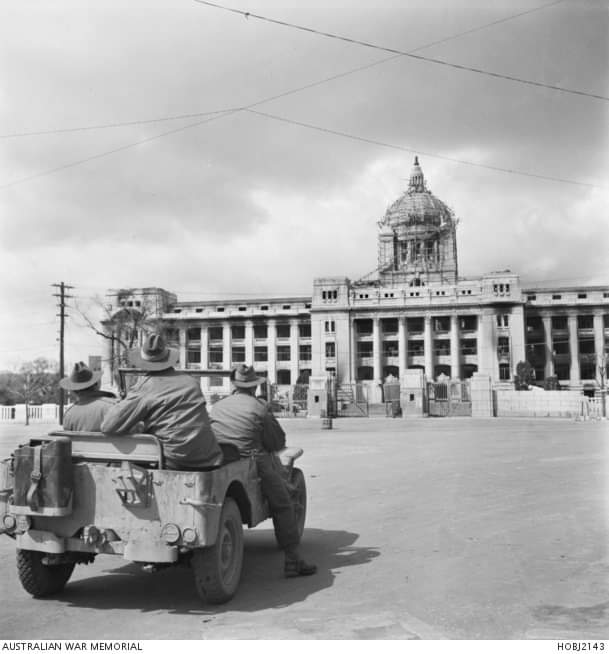
-
 1
1
-
-
“Rosemary” 77 Squadron’s lucky lady:
In April 1951, No. 77 Squadron, RAAF was withdrawn from Korea to re-equip with the Gloster Meteor Mk 8 fighter in Japan.
One of the squadron’s original Meteors would come to be known as “Rosemary” – Rosemary served with 77 Squadron in Korea from July 1951 until August 1953, flying 485 operational missions, including reconnaissance, ground attack and air to air combat. On 3 November 1951, Sergeant Max Colebrook DFM USAM damaged a MiG during a dogfight flying Rosemary. He was later awarded the Distinguished Flying Medal. Colebrook was later shot down on 30 March 1952, flying a different Meteor, and is one of 43 Australians listed as Missing in Action in Korea.
Today, Rosemary is part of the National Collection of the Australian War Memorial. Rosemary’s nose section is displayed in the Korean War galleries. http://ow.ly/vmVK50AbY7V
Her ladyship in action:
http://ow.ly/rcKb50AbY7UPhoto: Gloster Meteor Mk 8 jet fighter, serial number A77-368
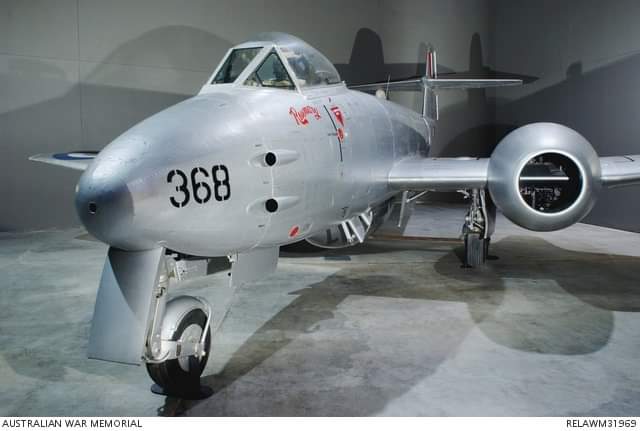

-
 1
1
-
-
One of the victims of the Korean War, Chan, an orphan, salutes Corporal Edward Dowell from the Royal Australian Army Medical Corps. He holds a wooden pull along toy with a duck in the centre, made by members of 1RAR for children in villages near the Jamestown Line area in June 1952. (HOBJ3125).

-
 2
2
-
-
Thirty Australians servicemen were captured during the Korean War. Private Bill Madden died in captivity and was posthumously awarded the George Cross. Don Buck, Tom Hollis, Keith Gwyther and Bob Parker from 3RAR banded together, attempting multiple escapes, and remaining close friends after the war. On 25 June 1952 – the second anniversary of the beginning of the war – 24 prisoners escaped. When they were re-captured several days later, Don Buck was identified as the ringleader and was heavily punished. The Australians were dubbed “reactionaries” and subjected to punishment and re-education, including beatings and torture.
Read more: http://ow.ly/SneV50AaUSm
Image: Chinese propaganda photograph: four Australian prisoners of war at Camp 5, Pyoktong, North Korea, wearing Chinese-issued padded uniforms. Left to right: Privates Bob Parker, Keith “Mo” Gwyther, Tom Hollis and Corporal Don “Old Man” Buck. (P03874.006)
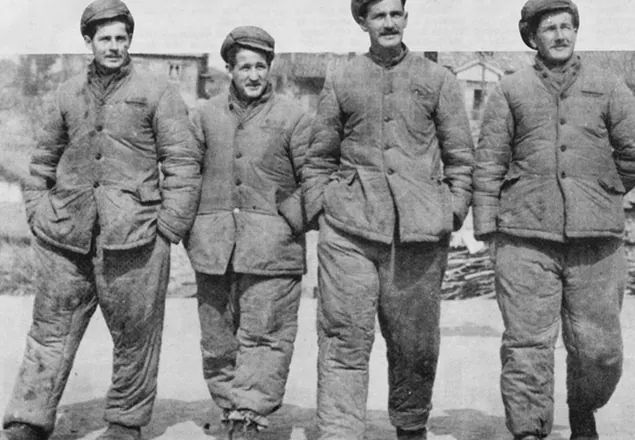
-
 1
1
-
-
This is a view of "the island" of the #aircraftcarrier HMS Ocean by #officialwarartist Frank Norton. Norton was deployed to the Royal Australian Navy in Korea for 5 months in 1952. He made more than 50 works documenting the ships, the technological environments of the Navy, and the sea.
To see more of Norton’s Korean War works: http://ow.ly/rT5a50A8I0v
#MyAWM #AWMemorial #RAN #Korea #RoyalAustralianNavy
Image: Frank Norton ‘HMS Ocean, the island’
(1952 oil on canvas on plywood, 61 x 66 cm)
ART40015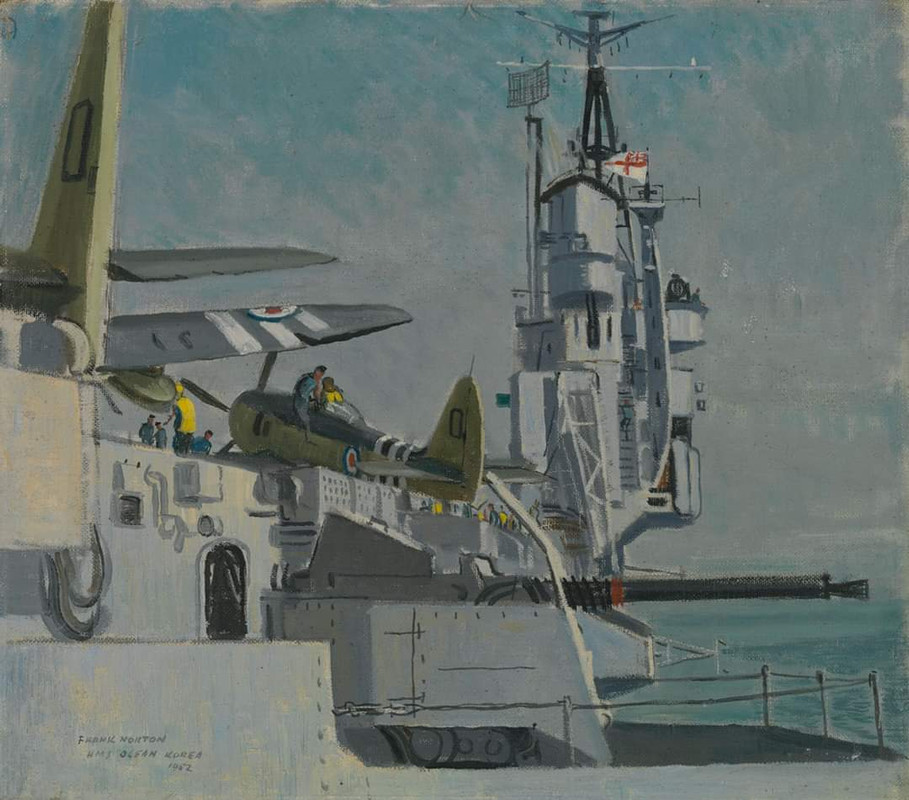
-
To mark the 70th anniversary of the North Korea, November 1950. Australians of 3RAR march along the road from Kunu-ri during the retreat. (148896)

-
#Onthisday 19 June in 1952 the 1st Battalion, Royal Australian Regiment, relieved the 1st Battalion, the Leicestershire Regiment, on the Jamestown line in Korea.
Over the next year, the battalion undertook nightly patrols to control no man’s land and provide security against direct attack. Minefield fences were repaired and maintained and raids were conducted to capture prisoners and gather intelligence. Learn more: http://ow.ly/3rKF50A3tYF
#KoreanWar70Years
Photo: Four Corporals of A Company, 1st Battalion, Royal Australian Regiment (1RAR) at sea on board the SS Devonshire embarked for service in Korea.
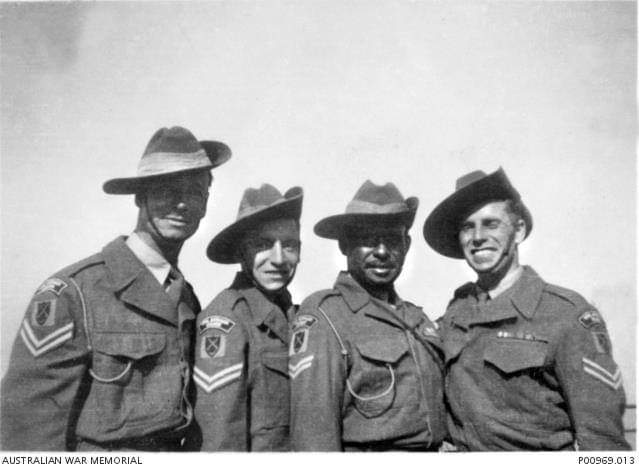
-
Nicknamed "the grey-headed old bastard" by the men of 3RAR, Brigadier Basil Coad welcomed Australian troops to Korea by saying: "I have always admired Australian soldiers and to have a battalion in my brigade is a dream come true."
Coad had held commands during the Second World War, was awarded a DSO for his leadership and bravery at Normandy and a Bar to the DSO for his actions during the invasion of Germany in 1945.
Coad developed a strong relationship with 3RAR's commanding officer, Lieutenant Colonel Charles Green. After Green's mortal wounding, Coad kept a picture of himself with Green in Korea on his desk for the rest of his life.
Firm, fair and a born leader of men,he was an inspiration to those he led, and the men of 3RAR have never forgotten him.
Read more: http://ow.ly/W8mg50AaQOq
Photo: Brigadier (later Major General) Aubrey Coad with Lieutenant Colonel Charles Green after conducting a forward reconnaissance near Chongju. It is the last known photograph of Green before his death.
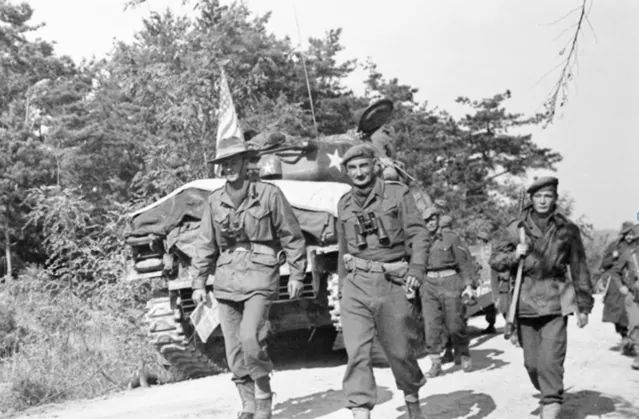
-
A view of the destroyed road bridge over the frozen Han River separating Yongdungpo and Seoul. Note the jute sandbags stacked in the foreground which are being used by a guard from Republic of Korea (ROK) Army (out of picture).
Photographer: Phillip Oliver, Hobson
Photograph: HOBJ2043#PhotoOfTheWeek #KoreanWar70Years

-
Plans for Operation Roundup began on the island of Yong Pyong Do. On 15 May 1952, Warwick Seymour Bracegirdle, commander of the Bataan, went ashore on the island to meet the Wolfpack leaders and inspect installations. The guerrillas sought Bracegirdle’s support for a plan to attack the mainland and push the North Koreans back from a communist-held mainland peninsula, Ponggu-yon. Local intelligence had revealed that Ponggu-yon was held by at least two battalions of North Korean and Chinese troops, supported by artillery. If the plan succeeded, it would provide greater security for the islands and the guerrillas who occupied them. Bracegirdle could see the advantages, and offered the guerrillas his support for the operation.
Read more: http://ow.ly/TAo650A2xaw
Image: Crew members play cards, smoke and enjoy hot drinks before lights out in the stoker’s mess aboard HMAS Bataan. The men are (left to right) Able Seaman Arnold Anderson, Leading Seaman Frank Seymour, Able Seaman Harold Hoogwerf, Able Seaman George Sewell and Able Seaman Malcolm Stott. (HOBJ3419).
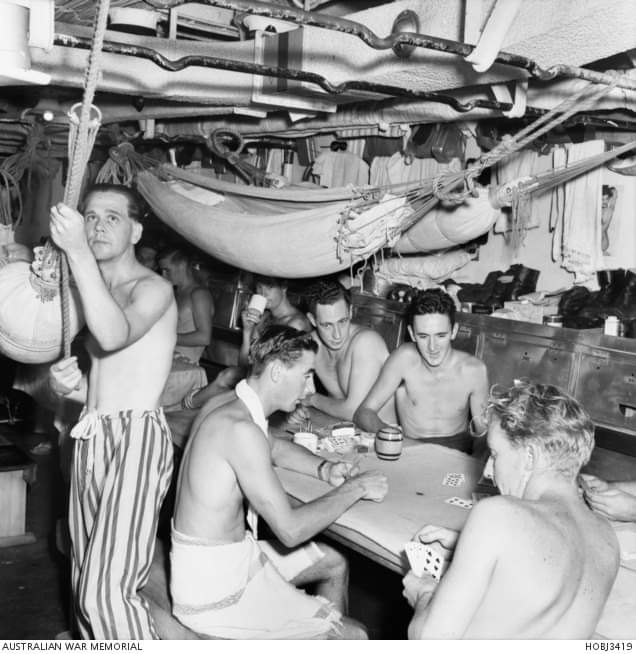
-
 1
1
-
-
Image: Portrait of Sergeant Stafford Kenny James 'Len' Lenoy an Indigenous serviceman from the KuKu Djunkan and Butchular Nations. This portrait was taken by Ian Robertson on 19 February 1951 at Chuam-ni, South Korea. Lenoy served during the Second World War in the Aitape-Wewak campaign and transferred to 67 Battalion at the end of the war on Morotai for occupation duties in Japan. Lenoy was the Medium Machine Gun Section Commander in A Company, 3RAR during the battle of Kapyong on 24 April 1951 when he was killed in action. (P01813.802).
Read more here: https://www.awm.gov.au/articles/blog/snapshots-from-korea
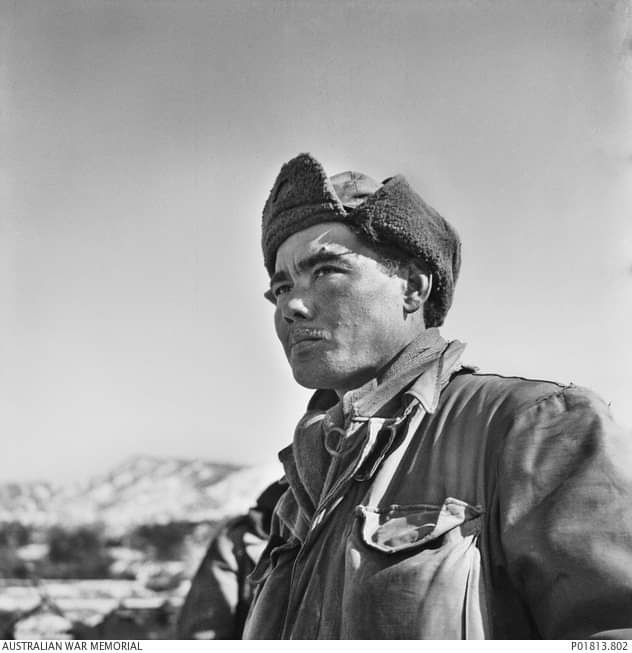
-
 1
1
-
-
#officialwarartist #IvorHele completed more than 30 portraits of service personnel during his 4 month deployment to Korea, concentrating on the individual's experience of the conflict.
To view more Korean War portraits: http://ow.ly/Wdc350zZn69
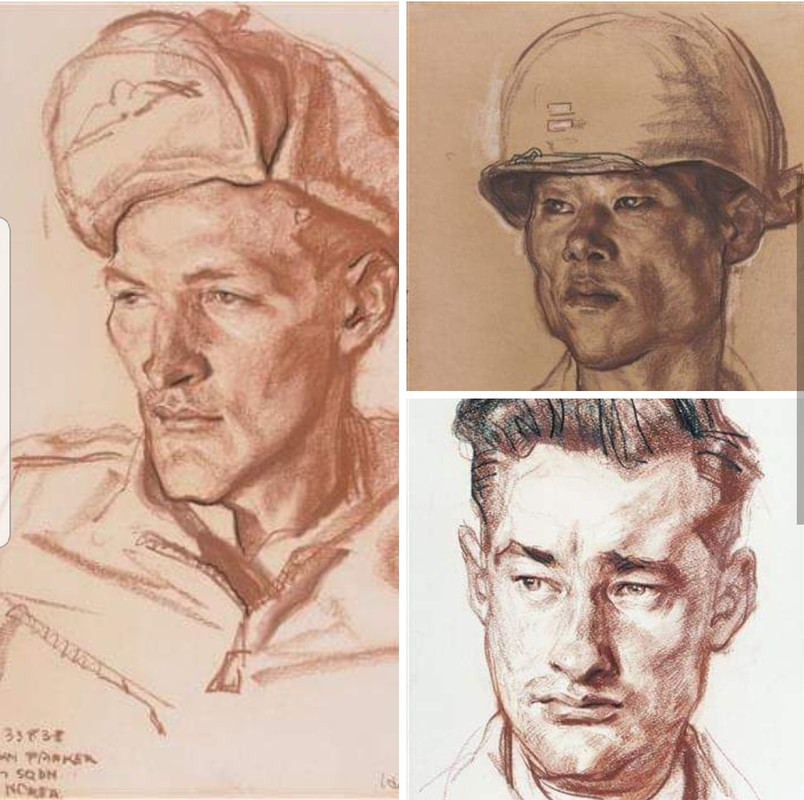
-
 1
1
-
-
I try my best to remember the past and those that gave so much so we can live the life we lead today
I try to do this and share things with people to educate and hopefully keep the stories going
Sadly I have been a bit caught up in my own world and haven't got back to this
Shame on me
Anyway some more
Paul

Image: Private Charles Felsman, Private William Bailey and Corporal Herbert Perry have to send their Korean mascot, "Hotrod" back to Pusan after his parents were located. "Hotrod" was cared for by the Australian Field Maintenance section since it landed in Korea. They are standing on front of a Douglas C-47 Dakota which will fly him to Pusan.
Hundreds of Korean children displaced or orphaned by war were 'adopted' by United Nations units as mascots, houseboys and washboys. "Hotrod" was probably one of the few who were reunited with family.
-
 1
1
-
 1
1
-
-
6 hours ago, Maxidyne said:
BTW, does anyone have the actual Mack transmission fluid recommendation?
Yes as I said before sae 50
Hope this clears it up
Paul


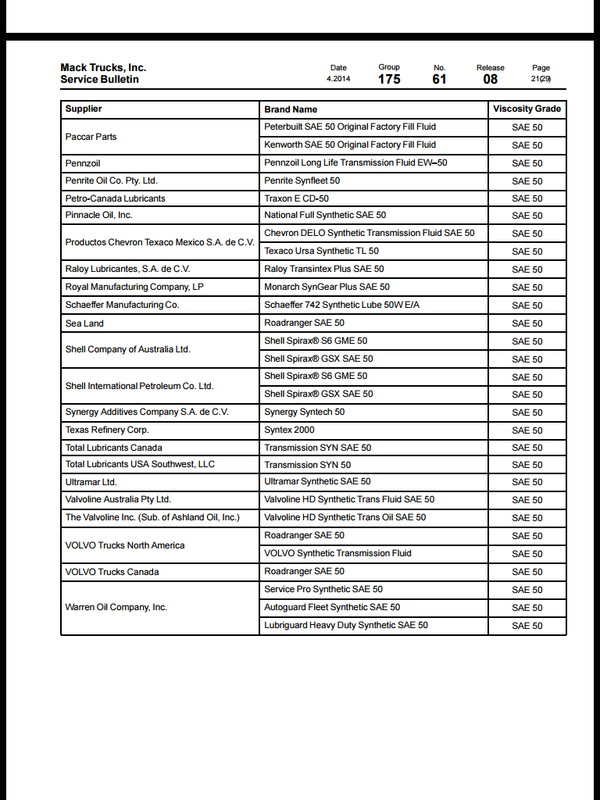
-
 1
1
-
-
Well I guess you need to ask your self why you want to change it
Oil bath lasts for ever and work as well if not better than a paper element type
Only down side to a oil bath is you can get a bit messy when service time is due
Oil bath are cheaper to own and operate and work far better in extreme conditions
Dunno if -40 changes the efficiency of them as I have never been anywhere that gets that cold
So I would just leave it
Paul
-
 1
1
-
-
Hytran would work fine, it's thin, runny and is built for extreme gear use amd as a bonus it wont froth and can do hydraulic work as well
Hytran feels like a similar viscosity to what you might normally use in a Mack box
According to Google
Hytran is a sae 10 and a sae 50 is what Mack recommended
Is this one fith as thick or is it some other measurement ? Dunno sliding scales and what not ???
I know it feels similar as it runs thru your fingers
I dont know why you would want to but if you chose to I think it would work fine
Paul
-
Ok you jokers are all getting serious on some other threads here and need to lighten up a bit and have a good chuckle at Brown Dog
You may get lost in some Australian talk and may need to listen to it a few times to fully get it
I had to and I live here
Laugh my head off every time I hear it and the sequel
There you go
Have a laugh
Paul
-
Welcome, we are a pretty friendly bunch
What problems are you having ? thats truck related problems 😀
Paul
-
- Popular Post
- Popular Post
Well bugger me, I didn't see this coming, not that I would
I very much doubt I would ever go back for a second go at marriage, Ive been punished enough this go around 😃😃😃
Well done to the two of you and hope your as happy as can be
Paul
-
 2
2
-
 1
1
-
Welcome to the forum and keep us posted as you move along
Paul
-
I dont even notice the aircleaners on my R model so I guess the answer to your question is no they dont block your vision
Paul
-
 1
1
-



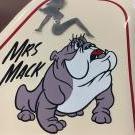

70 years Korean war
in Odds and Ends
Posted
As I have said before, I haven't watched mainstream media since the GFC and my life just ticks along the same, actually it ticks along a lot better
I sleep better, I get less angry and I find the world still is pretty nice place or at least my world is
Everyone please add what ever you can or feel comfortable to share with us
It's a real shame as it appears by and large this is the forgotten war, we dont want let that happen
Paul